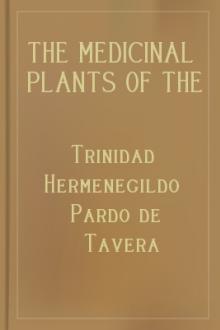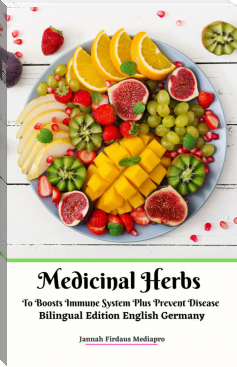The Medicinal Plants of the Philippines by Trinidad Hermenegildo Pardo de Tavera (best pdf ebook reader for android TXT) 📖

- Author: Trinidad Hermenegildo Pardo de Tavera
- Performer: -
Book online «The Medicinal Plants of the Philippines by Trinidad Hermenegildo Pardo de Tavera (best pdf ebook reader for android TXT) 📖». Author Trinidad Hermenegildo Pardo de Tavera
Papain is an amorphous substance, perfectly white, soluble in water, insipid, odorless. An aqueous solution, if shaken violently, foams like a solution of soap. Boiling makes it turbid and when concentrated it has a slightly astringent taste. It is precipitated by hydrochloric, nitric, picric and the metaphosphoric acids. Trommer’s test gives it a beautiful blue violet color which, on boiling, changes to a red violet.
It is an extremely active digestive ferment, comparable with pepsin, but superior to the latter because it does not require an acid medium, as its digestive action takes place even in the presence of an alkaline medium and of antiseptic substances such as boric acid, phenol, etc. It is given in doses of 10–40 centigrams in different vehicles such as water, wine, etc. It should be given after meals carefully and properly diluted, in order that its action may not be exerted upon the gastric mucous membrane itself. Its use is contraindicated in gastric ulcer.
A watery solution prepared by macerating the green fruit has been used effectively to remove blemishes from the face, leaving the skin clean and smooth. The natives use little pieces of the green fruit to remove freckles (which they call pecas). The ripe fruit is edible and its taste quite agreeable; in some of the Malay Islands it is given for dysentery, but it must be remembered that the ripe fruit does not contain papain.
The pure exudate is given to children as an anthelmintic in doses of 2–6 grams with a little molasses, but it is not so harmless that it may be used with impunity in this form, Moncorvo and others having reported cases of peritonitis with symptoms suggestive of cholera following its use. It is drastic and digestive in addition to its anthelmintic action, but according to Rabuteau, boiling destroys the first property without affecting the others. Dr. Lemarchand of the island of Mauritius gives the following anthelmintic prescription:
Add gradually while shaking the mixture.
Cool and administer in one dose followed immediately by 30 grams of castor oil. For a child, one-half dose.
This treatment frequently causes colic, for the relief of which the author advises an injection of sweetened water. Sir O’Shaughnessy’s prescription is preferable:
This dose cannot cause any untoward symptoms and is efficient in expelling both lumbricoids and tæniæ.
The triturated seeds may be given internally in doses of 1–2 grams with milk or molasses to expel lumbricoids. Analysis has revealed in the seeds the presence of a resinous oil, an oleaginous material of disagreeable odor and taste called by Peckolt caricin, a fatty acid, papayic acid and a resin. In India the seeds are considered emmenagogue. In some countries they wrap meat in papaya leaves for several hours before eating in order to soften it. For the same purpose they sometimes boil the meat in water containing a few leaves or pieces of the green fruit; some even go to the length of saying that it is only necessary to hang a piece of meat in a papaya tree for a time in order to soften it.
The decoction of the green fruit is given internally for indigestion, a treatment common in the provinces of Bulacan and Pampanga. The milky juice is used to remove corns and Dr. Daruty offers the following prescription for eczema and psoriasis:
Mix.
Paint the affected part with feather or brush, 2–3 times a day. The same solution may be used for softening corns.
Botanical Description.—Trees 15° in height, trunk covered with large leaf scars, wood soft and brittle, the long-petioled, palmately-lobed leaves growing in a crown and giving the tree the general appearance of a palm. Flowers diœcious. Staminate tree: Flowers loosely clustered on long, hanging stems. Calyx, 5–6 teeth. Corolla tubular, 1′ long, limb divided into 5 oval parts. Stamens 10, inserted in the throat. Style short, awl-shaped. Pistillate tree: Flowers much larger, sessile, in axils of leaves. Calyx 5-toothed. Corolla large, 5 lanceolate petals curved outward, fleshy. Stigmas 5, fringed. Fruit about size of child’s head or smaller, somewhat pear-shaped, juicy, pulp melon-like, 1 compartment with numerous seeds, each in a mucilaginous aril.
Gourd Family.
Trichosanthes palmata, Roxb. (T. tricuspis, Mig.; T. lucioniana, Bares.)
Nom. Vulg.—(?).
Uses.—Roxburgh states that the fruit is toxic and sometimes used to kill crows. Dymock states that the leaf is smoked in Bombay as a remedy for asthma.
The extremely bitter taste of the fruit and rind induced Sir W. O’Shaughnessy to examine it for tonic and purgative properties; doses as high as 0.20 gram 3 times a day failed to exert a purgative effect. The root is used in veterinary medicine particularly for pneumonia. Mixed with equal parts of colocynth it is applied to carbuncles. In combination with equal parts of Terminalia chebula and ginger it is made into a sweetened infusion for internal use in gonorrhœa.
Botanical Description.—A climber with broad, heart-shaped, serrate, 7-lobulate leaves. Flowers monœcious; staminate white and racemose; pistillate solitary, growing at the base of the staminate racemes. Staminate receptacle tubular, calyx inserted on the border of the receptacle, 5 sepals. Corolla, 5 petals. Stamens 5, of which 4 are in pairs. Pistillate: the receptacle dilates in its lower part in form of a globose vase and encloses the unilocular pluriovulate ovary. Fruit ovoid or pyriform, scarlet when fresh, orange-yellow when dry. Seeds of irregular form, somewhat triangular. Kernel oily.
Habitat.—Luzon.
T. anguina, L. (T. amara, Blanco.)
Nom. Vulg.—Salagsalag, Pakupis, Salimpokot, Kukubitan, Halahala, Buyokbuyok, Tag.; Tabobog, Kukubitan, Pukopukot, Kuragda, Vis., Pam.
T. cucumerina, L.
Nom. Vulg.—Probably the same as T. anguina.
Uses.—The fruit of T. anguina is purgative, emetic and anthelmintic. The natives use an infusion of the filamentous, reticulate portion surrounding the seeds, in doses of 0.50–0.60 gm., according to P. Blanco.
The second species, T. cucumerina, has a wider use. In India it is regarded as a febrifuge and laxative and is commonly given with some aromatic. Ainslie notes that the leaves, as well as the fruit, are bitter and purgative and that the Tamuls use them for their laxative and stomachic effect. Drury states that on the Malabar coast the seeds have a considerable reputation as a remedy for functional disorders of the stomach. Although the green fruit is very bitter the natives of that region use it as a condiment. The tender stems and the dry capsules, both bitter and purgative, are given in infusion and in a sweetened solution, as an aid to digestion. The seeds are febrifuge and anthelmintic. The juice of the leaves is emetic and that of the roots purgative. The decoction of the stem is expectorant.
In Bombay the plant is considered febrifuge, and is given in decoction with ginger, Swertia chirata, and sugar. The Mohammedan authors say that the T. cucumerina is effective in expelling lumbricoids and one of them mentions the following as a cure for stubborn fevers:
Let stand over night, filter, add a little sugar, administer in 2 doses morning and evening.
In Concan they use the juice of the leaves as a liniment in remittent fevers, rubbing the hepatic region and in fact the entire body.
Botanical Description.—T. anguina, L., is a vine with 5-angled stem, bearing tendrils and spattered with white dots. Leaves heart-shaped, with 5 acute lobules, spiny-toothed. Petioles with a bifid swelling at their bases. Flowers white, monœcious. Staminate: calyx 5-toothed with dotted borders; corolla, 5 fringed petals; stamens 3; anthers 3, entirely united and forming a cylinder. Pistillate: 3 glandules in the corolla tube; style long; stigmas 3. Fruit ribbed, long, the compartments formed by reticular partitions; contains many irregular seeds, one border sharp, the other obtuse, covered by a very thin aril.
The T. cucumerina, L., is less common, bears a spindle-shaped or obovate fruit, is hairy and lacks ribs. Its seeds are ovoid, very smooth, encircled by a narrow wing. The reticulum within the fruit is similar to that of the foregoing species.
Habitat.—Common in all parts of the islands. Blooms in October.
Lagenaria vulgaris, Ser.
Nom. Vulg.—Common Gourd, Bottle Gourd, Calabash, Eng.
Var. Lagenaria Gourda, Ser. (Cucurbita lagenaria oblonga, Blanco.)
Nom. Vulg.—Calabaza de peregrino, Sp.; Pilgrim’s Gourd, Eng.
Var. L. courgourda, Ser.
Nom. Vulg.—Tabayag, Tag.
Var. L. clavata, Ser. (C. lagenaria villosa, Blanco.)
Nom. Vulg.—Calabaza blanca, Sp.; Opo, Tag.; White Gourd, Eng.
Uses.—The three above-mentioned varieties of L. vulgaris, Ser., are commonly grouped under the name calabaza (gourd). All have the same action and hence the same therapeutic application. The green portion of the rind is bitter and possesses purgative and emetic properties. The decoction of the tender shoots is expectorant; in addition it appears to possess purgative properties and in India is used in jaundice.
The part of the plant most generally used is the seeds, the tænifuge properties of which are well known. Its action, however, is not always certain, which may be as truly said of all other known tænifuges. The seeds have the advantage of lacking the disgusting taste characteristic of other remedies of the same class; the taste is almost neutral and a little sugar conceals it completely. The dose is unlimited; some take 15 grams, others as high as 100, and no unpleasant symptoms of any kind have been reported. The only precaution to be observed is to give the patient a purgative 1–2 hours after his dose.
Heckel has analyzed the seeds and found a resin which he calls pepo-resina; it exists in the greenish pellicle that envelopes the embryo and appears to be the active principle of the seeds. Its dose is 0.80–1.00 gram (Dujardin-Beaumetz), the product of 250 grams of the seeds. The dose of 100 grams of the seeds mentioned above is very small, if the pepo-resin represents the entire active principle, for 100 grams of the seeds would only contain about 40 centigrams.
Botanical Description.—A very familiar vine, clammy, pubescent and musk-scented; large leaves, long-stalked flowers, white petals, greenish veiny fruit usually club-shaped or enlarged at the apex, the hard rind used for vessels, dippers, and so forth. It is noteworthy that none of the tænifuge varieties mentioned bears yellow fruit.
Luffa Ægyptiaca, Mill. (L. pentandra, Roxb.; L. petola, Ser.; Momordica operculata, Blanco.)
Nom. Vulg.—Probably bears the same names as the Trichosanthes.
Uses.—The root is a hydragogue cathartic even in minute doses. The fruit is emollient by virtue of the large quantity of mucilage it contains, but it is more interesting for other properties. When cut in two, deprived of epidermis and seeds, and washed until none of the mucilage remains, there is left a fibrous skeleton, a sort of skein of interwoven nets that constitutes the so-called vegetable sponge. It serves the same purpose as a sponge and has the advantages that its fibers do not rot and that they are easily kept clean. In view of its cheapness and plentifulness in the Philippines the above advantages should suffice to bring it into universal use for the toilet, for surgical purposes and for cleaning in general.
Botanical Description.—A vine with square, glabrous stem. Leaves alternate, cordate, 3–5-lobulate, dentate, rough, 5–7-nerved. Petioles short. Flowers monœcious. Staminate in axillary panicles; calyx bell-shaped; corolla





Comments (0)